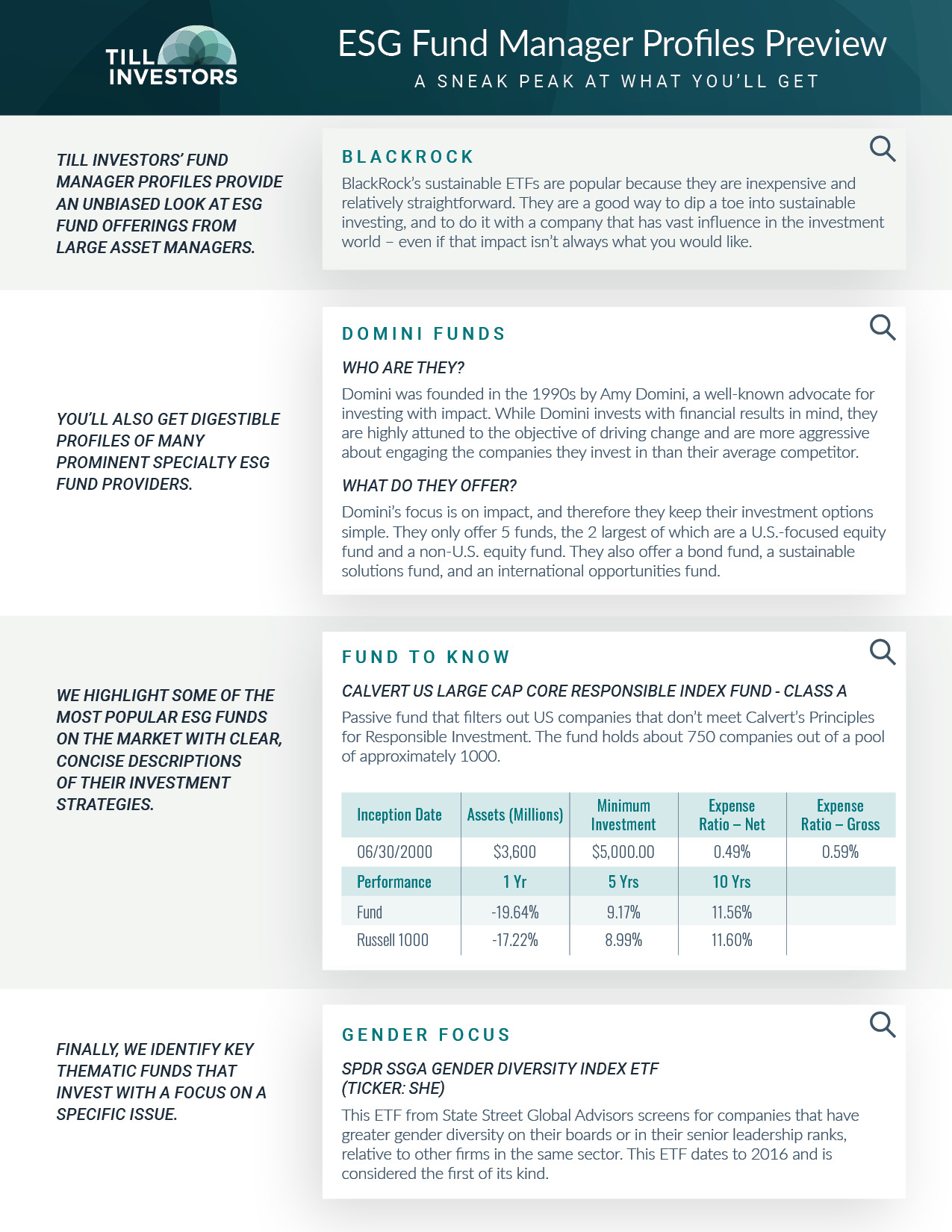Active vs. Passive Sustainable Funds: What’s Better for Investors?

One reason Till Investors likes meeting and talking with investors is that we learn a lot about how people look at sustainable (aka ESG) approaches. At a recent educational session we hosted with Invest for Better, for example, a debate broke out about the role of fees.
The consensus is that investors don’t like them and prefer them to be as low as possible, which makes sense. But when deciding to invest based on your values, it’s hard not to notice that sustainable fund fees are often higher than traditional funds – consistently, if not necessarily by a lot. That leads to a natural question: Why? What exactly are you paying for?
Buy More, Pay More
Fees represent the cost it takes to run a mutual fund or ETF. Over the past few decades, ‘passive’ funds that simply follow a formula or track an index, which can be very cheap and easy to do, have exploded in popularity. Larger fund managers like BlackRock, Vanguard, and Fidelity have worked hard over the years to lower their fees on these funds as much as possible – Vanguard’s S&P 500 ETF, for example, one of the largest ETFs in the world, has a fee of just 0.03%.
Passive funds stand in contrast to their ‘active’ brethren – funds where a manager or team of managers make day-to-day investing decisions, based on research performed by analysts. Fees are higher on active funds because paying people to research and make stock selections costs money. For example, a popular actively-managed fund, the JP Morgan Large Cap Growth fund, has a gross fee of 0.77%. It isn’t a lot, but it’s more than 20 times higher than the Vanguard passive fund.
Sustainable investing adds a new twist. Doing anything beyond just tracking the markets – whether it’s screening out bad companies, paying for corporate sustainability data, or engaging with companies you invest in – requires people, and people cost money. For this reason, it’s almost inevitable that sustainable funds will have higher fees. Research we put into our book shows that, on average, sustainable funds have expenses that are higher than traditional passive funds, but on par with traditional actively managed funds.
If you’re wondering whether you can get sustainable funds at passive fund prices, the answer is yes. But should you?
Passive ESG Funds: An Inexpensive Step toward Sustainability
The best passive ESG funds look for ways do sustainability as cheaply as possible. The largest passive ESG fund in the world, Blackrock’s ESG Aware MSCI USA ETF, is a great example. They track an MSCI-provided ESG index, which uses a standardized formula to rate companies based on their published sustainability data. The fee is low, just 0.15%.
A lot of ‘thematic’ funds – that is, funds that favor a particular investment theme or economic sector – are also set up as passively managed ETFs. These are more costly than the broadest passive ESG funds, but still can be cheaper than some active funds. For example, Invesco’s Water Resources ETF has a fee of 0.60%. A wide range of sustainable themes are available – clean energy, women’s leadership, divesting from fossil fuels, ‘green’ corporate bonds and many others.
However, with passive funds, you’re giving up some things in the bargain. The investment formulas these funds rely on use data that isn’t always clean, consistent, or meaningful. They also make sweeping decisions about how the data will be applied. If you want to invest in renewable energy leaders, for example, a fund that simply avoids the entire energy sector is not for you.
Perhaps more important for values-oriented investors, passive funds also don’t actively engage on sustainability-related issues with the companies they’ve invested in. BlackRock has struggled to find their footing on engagement, taking one step forward and one step back. It’s a similar story at Vanguard, which recently backed out of the Net Zero Asset Managers initiative. So, while your money may be invested in a way that you like, the people managing that money may not have your values at heart when voting at annual shareholder’s meetings.
Active ESG Funds: More, if You’re Willing to Pay for It
Active management is where sustainable investing began, and really, where the heart of values-based investing still lies. The longest-running sustainable investment funds are all actively managed.
In our experience, the funds that do the best job of giving sustainable investors what they are looking for are those that invest in analysis and engagement teams. They do a better job at finding nuance in sustainability data and asking companies tough questions. They are faster to recognize and apply improvements in sustainability data. And they are active about engaging with companies on key ESG-related issues, and voting their proxies in favor of sustainable initiatives.
All of this takes work, and more work means more in fees. As an example, the Parnassus Core Equity Fund, has a fee of 0.82%, and Domini’s Impact Equity Fund has a fee of 1.00%.
Active ESG funds make sense for a certain kind of investor, one who:
- Prefers a more thoughtful, robust sustainability strategy
- Is meaningfully committed to emphasizing sustainability in their investments
- Believes in the data that suggests long-term ESG performance is better than traditional results
However, it will be important to watch out for greenwashing. Not every ESG fund that charges a higher fee is using it to support better sustainability research and engagement. As we often tell people, you can be a good greenwashing detective by looking for vague marketing language, use of the word “proprietary,” and reviewing shareholder reports to make sure you’re getting what you pay for.
Active or Passive? It’s Up to You
Both active and passive strategies have their place in the world of ESG. It comes down to what you’re looking for and what you’re willing to pay. You can find many funds, both passive and active, in our ESG Fund Manager Profiles.


